
21-27 September 2015. There are two entrances to our hotel in Goreme, in the Cappadocia region of Turkey, both with long, winding, narrow flights of stone stairs. We choose the “front” one expecting the airport shuttle to arrive from that direction. We are packed and waiting on the outside landing. While waiting for the shuttle I am aware that every time I’m in this situation I have a quiet anxiety that the shuttle will be late, or worse won’t show at all. Every time so far it’s been fine. Earlier in the day I’d given thanks for smooth travel since we left Vancouver. We’ve almost always had smooth travel, and may it continue, but I still get mildly anxious. Soon enough we hear the call from below and start hauling our cases down.
Reaching the shuttle we see there are a few people already on board. Our cases are loaded into the back and off we go. To the next hotel. More travellers climb aboard. Then another hotel and four more people. I’m flabbergasted by the amount of luggage people have. We travel with carry-on size cases and think we’re carrying too much. Some of the cases being stuffed in are as big as houses. I shouldn’t be so superior about it. When Don and I started travelling we had huge cases too. Now that we live on the road all the extras have fallen by the wayside, often literally.
I’m starting to feel a little concerned for the people in the back seats. A sudden stop and all of that piled-high luggage could come flying forward. Surely we are done by now and will head along the main road to the airport. But no. There is another stop. After travelling a while down the highway we turn into a small town for another stop! But where is the space for more people? And now I’m getting concerned that we’ll not make it to the airport in time for our flight back to Istanbul.
By the time we are finished picking up passengers every seat is full, the luggage area in the back is full to the roof, the aisle is full with more luggage, people are holding luggage on their laps, and at the request of the driver someone has offered, in exchange for a free ride, to sit on a makeshift seat between the driver and front passenger seat. I’ve sat in that seat before on a different shuttle ride. It’s terrifying. Your head is about twelve inches from the windshield. And seat belts? What are they? It’s the chicken bus without the chickens, but definitely with the fast reckless driver. I try not to look.
The nearest airport to Goreme is at Kayseri, which according to Google maps is a one-hour drive. It takes us two and a half hours, but we arrive in time for our flights. I guess those shuttle guys know their business.
We had allowed one jet-lag-recovery day in Istanbul before leaving on a four-week trip around Turkey – travelling to the ancient Roman ruins of Ephesus, one Aegean and two Mediterranean coastal towns, the terraces of Pamukkale, Konya (the birthplace of Sufism), and the extraordinary other-worldly landscape of the Cappadocia region. Now we have returned to Istanbul for eight more days of exploration. We met a couple in Pamukkale who were cycling across Turkey. They wondered what on earth we are going to do in Istanbul for eight days. We barely scratch the surface.
This time we stay at the downhome Piya Hotel and Hostel, in Sultanahmet, and have a private en suite room with all we need including a fridge and tea and coffee making facilities. We settle in and for dinner eat the chicken sandwiches we’ve been given on the flight.
The Bosphorus Straight, a north-south oriented body of water, divides Istanbul in half. The west side of it is in Europe, the east in Asia. I find it an odd and confusing distinction. Almost all of Turkey is east of the Bosphorus and yet one thinks of it as a European country. All Russia is east of the Bosphorus and yet is definitely regarded as a European country even though it stretches east all the way past China and almost to Alaska. According to Countries-ofthe-World Russia is in both Europe and Asia. So is Turkey and Kazakhstan. The dividing line is tenuous to say the least.
The Bosphorus, twenty miles long and two miles wide, is part of the Turkish Straights and connects the Black Sea to the Sea of Marmara to the Dardanelles Straight to the Aegean and the Mediterranean. This small chain of water is the one place on the map that a clear divide can be made between Europe and Asia. And throughout history, not surprisingly, it has been of great strategic importance for both merchant and military shipping, especially for Russia and Ukraine. It is Ukraine’s only access to the sea, and Russia’s only western access. It is like both the Suez and Panama Canals, only natural rather than man-made.
About seven and a half thousand years ago the Black Sea was a fresh water lake. There is a theory that with the melting of the immense ice sheets at the end of the last Ice Age the lake was flooded from the Bosphorus. The water rose an estimated seventy-two metres, or two hundred and forty feet. It was a spectacular flood that increased the water in the Black Sea Lake by fifty percent. The constantly rising water, no doubt both frightening and incomprehensible, drove the people out of the area. They spread to all parts of the Western world taking with them the story of the Great Flood. It is a contested theory, but could explain the myth of the Great Flood found in many religions.
Istanbul, a city of seventeen million, straddles the south end of the Bosphorus, spreading inland from both coasts. We make our way from our hotel down to the water. The closer we get the more we are accosted by touts wanting to sell us a Bosphorus cruise. I seem to remember the offers start at over two hundred Turkish Lira. By the time we get right down to the docks at Eminönü we have found a two-hour ferry cruise for twelve. It’s definitely a no-frills ride and suits us perfectly.
This is a busy waterway. Ferries, tourist cruise boats, fishing vessels, and even rowboats fill the water. Seagulls follow us screeching overhead. The air is full of the smell of fish and salt and exhaust, and the boat is full of fellow tourists.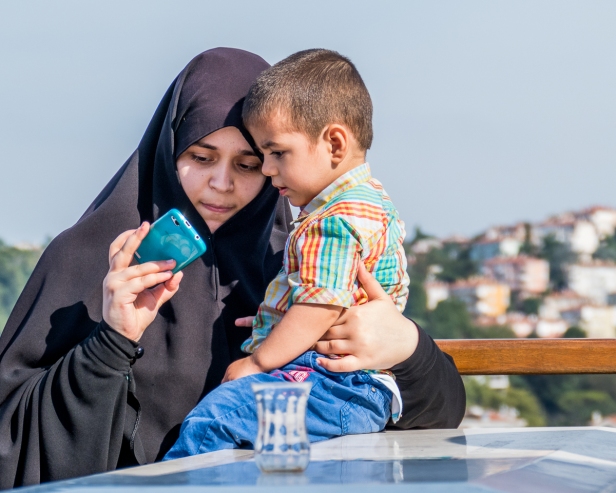
The breeze is warm, the sky is blue, and we slowly chug along taking in the waterside views of this huge city.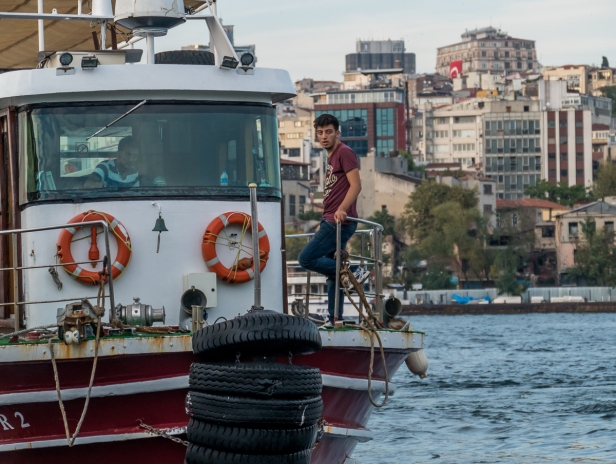


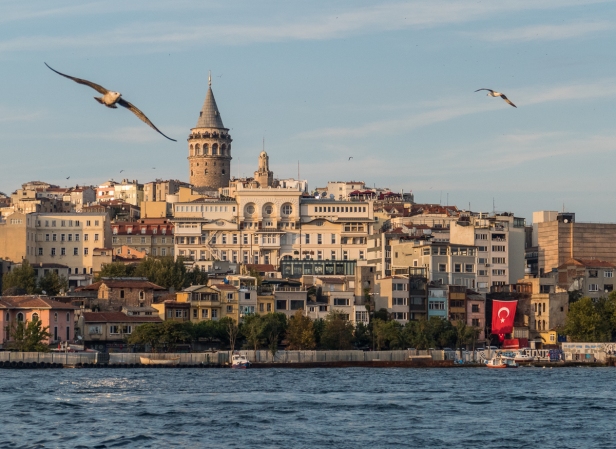
We float by the tiny but elegant Dolmabahçe Mosque, unusual in its style since it was designed as part of the Dolmabahçe Palace and resembles a decorated palace hall more than a traditional mosque.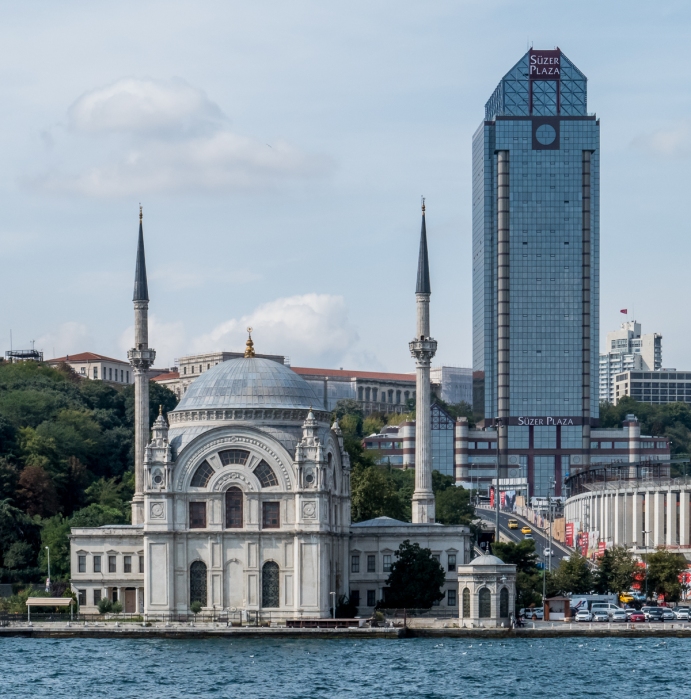
At the narrowest part of the Bosphorus Anadolu Hisari, or Anadolu Fortress, sits on the Asian shore. Rumeli Hisari, directly opposite on European side, was ordered built by the Ottoman Sultan Mehmed II in 1452 in order to control traffic along the Bosphorus.
Sultan Mehmed was one smart military man. He set his generals up as rivals, creating a competition to see which of them could finish their tower and crenelated walls in the shortest time. The contest was ferocious, and astonishingly the fortress was completed in only four months! By controlling commercial and military traffic he could prevent aid from the Black Sea reaching Constantinople some eight miles to the south. With the completion of the fortress he laid siege to Constantinople and by 1453 Mehmed had conquered the city.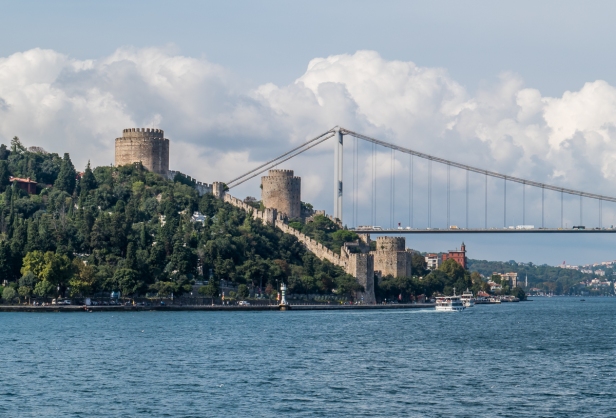
Right next to the fortress is the Sultan Mehmed Bridge, built in 1988. It is one of the longest steel suspension bridges in the world and is the second of two such bridges that cross the Bosphorus. A third is due to be completed this year.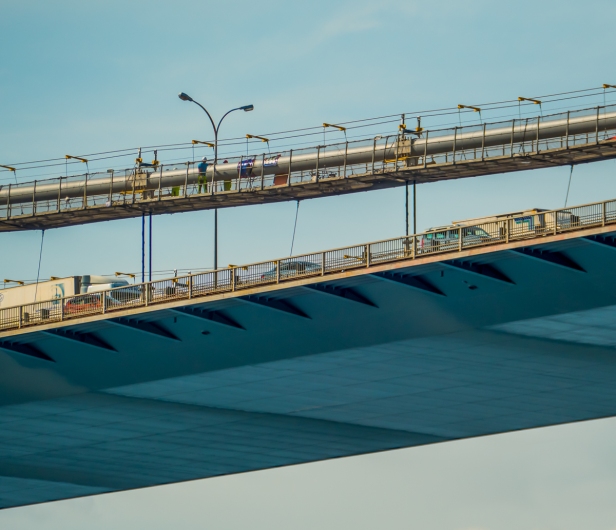
If you’ve seen the James Bond movie The World is Not Enough, and if you remember from that movie the mansion of a woman in Baku then you will have seen the (comparatively) tiny Küçüksu Palace. It was completed in 1857 and was used by Ottoman Sultans for country stays and hunting parties. They would arrive by royal barge.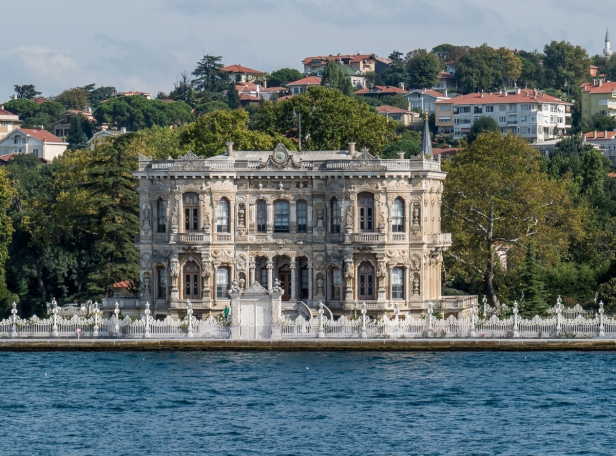
Approaching the Galata Bridge with Suleymaniye Mosque dominating the skyline.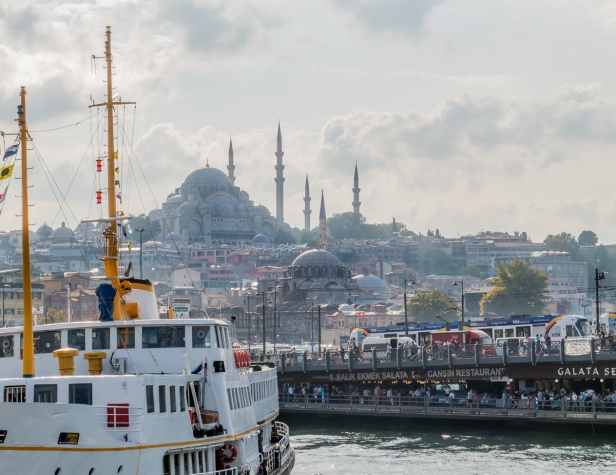
The heart of Istanbul is the Golden Horn and the Galata Bridge that spans it from Eminönü in Old Istanbul on the south side to Karaköy on the north. The Golden Horn is a major urban waterway and an inlet of the Bosphorus. With a little imagination it can be seen as roughly the shape of a horn. The golden part possibly refers to the colour of the water at sunset. Or to the riches that have arrived in this port over the millennia. The Turks call it simply Haliç, meaning estuary.
Galata Bridge has two levels, the upper one carrying vehicular traffic, trams and pedestrians, the lower one being a hive of restaurants and cafes serving food and drinks at all hours. We amble across Galata Bridge on a couple of different occasions, watching the fishermen
and the crowds of people, both tourists and locals.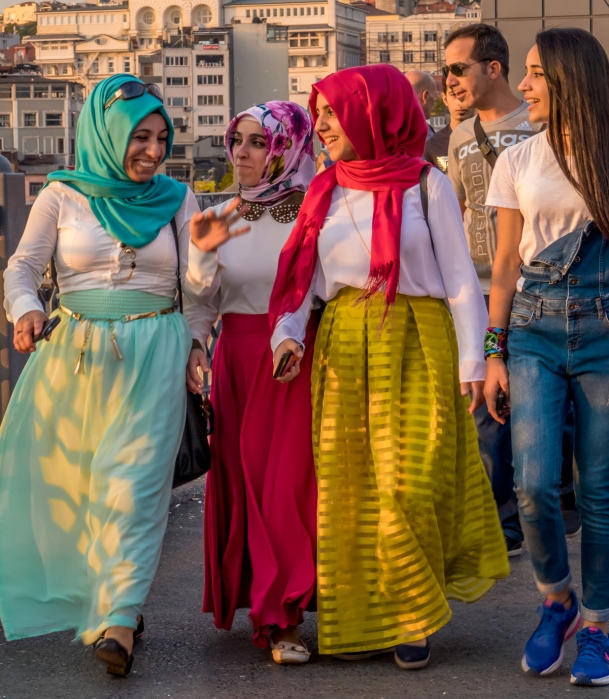
We meet and chat with a lovely local family,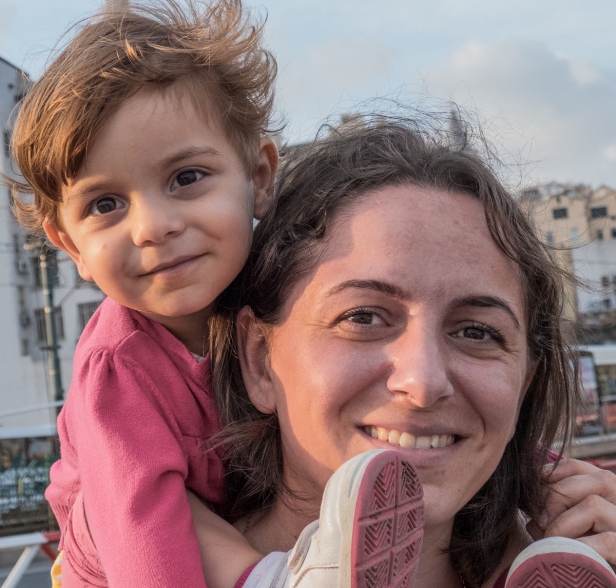
and on the Karaköy side we watch as fearless boys and men dive and jump over and over into the roiling water. They are having such a good time, so free and confident and joyous.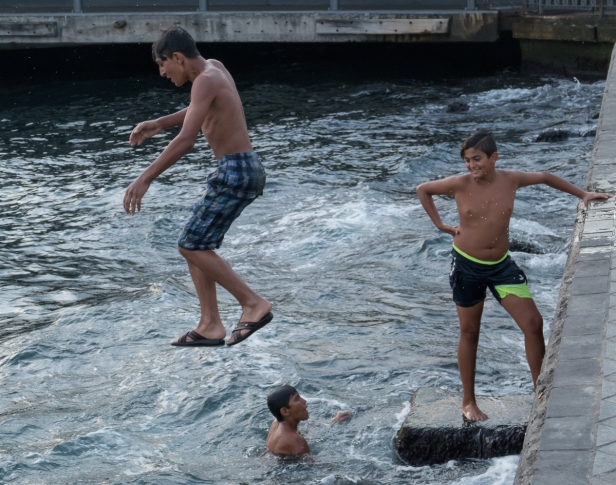
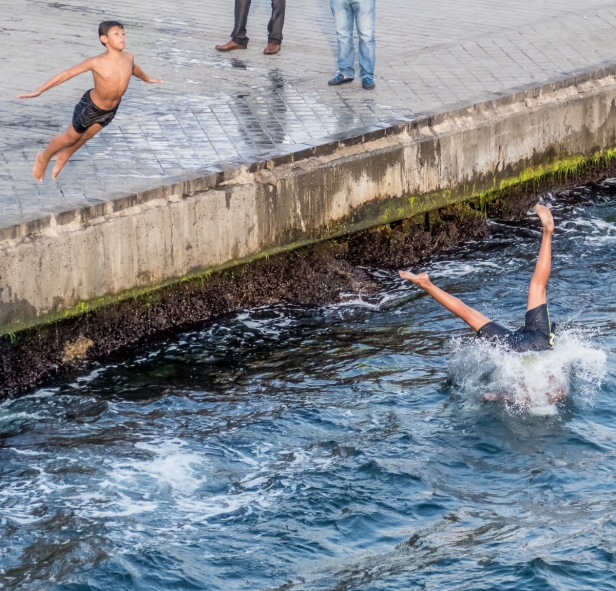
Wandering further away from the water we discover a fish market. The bright red gills of the fish are arrayed like spiked pennants.
We discover fading Ottoman era buildings, elegant Neoclassical and Art Nouveau apartment-blocks, that were once the homes of the élite, now homes to immigrants from the countryside, or converted to workshops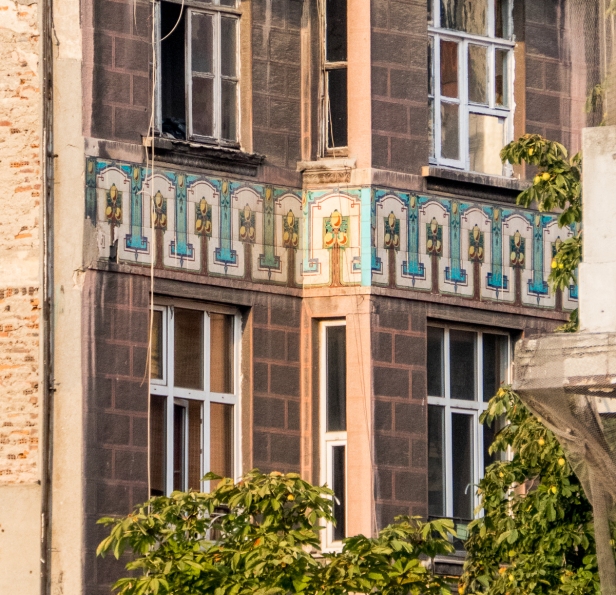
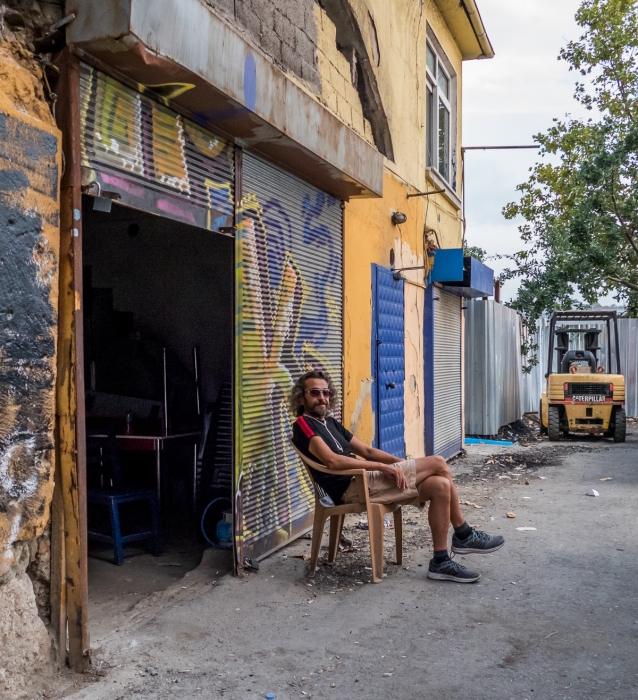
and we discover what I call ‘Fishing Street’ where fishermen can buy all the supplies they could possibly want.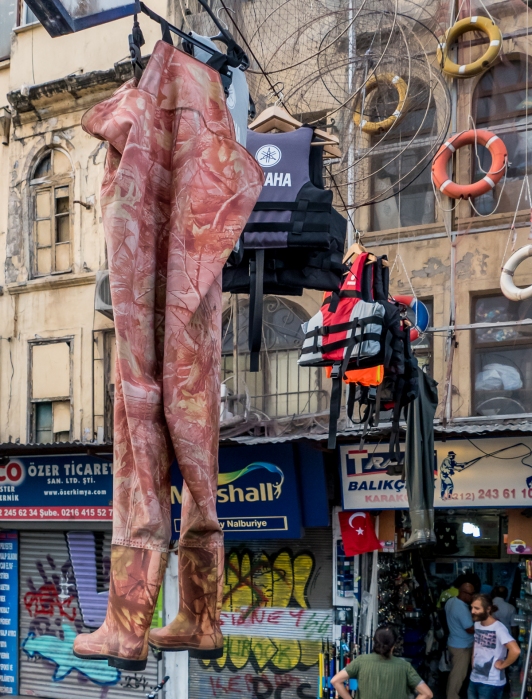
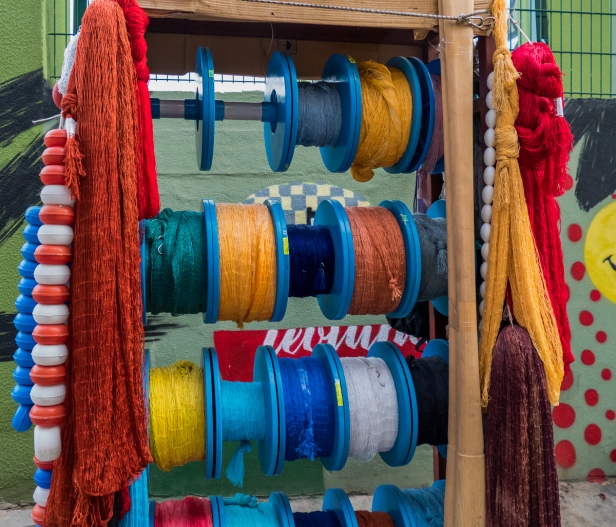
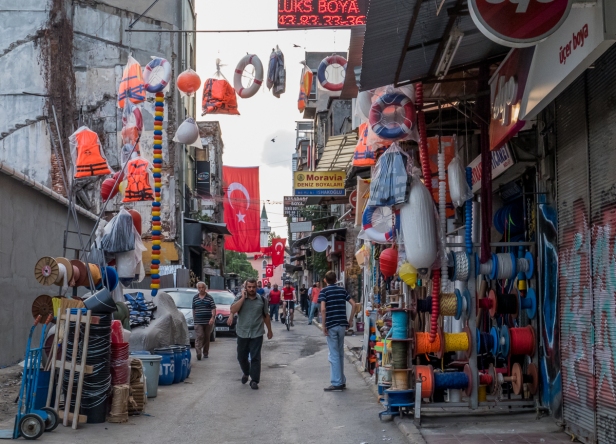
Further along it becomes ‘Painting Street’ with powders of all colours ready for mixing.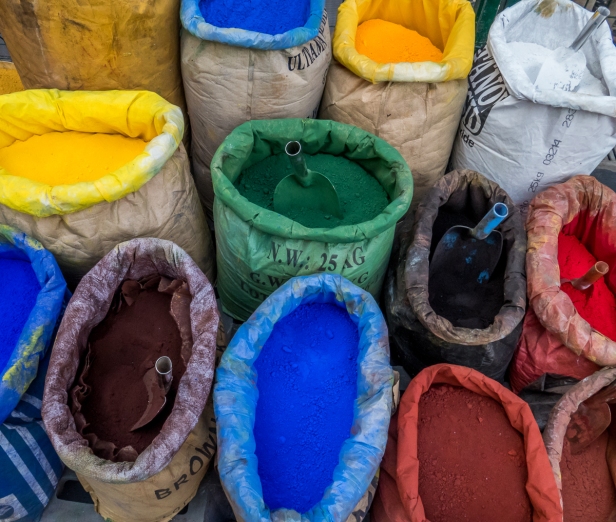
Walking back across the bridge towards the Sultanahmet side we catch the sunset, its light reflecting off the windows of the domed mosques and turning the waters of the Golden Horn golden. It is magical.
We take a tram part way home, stopping to eat chicken wings and salad at a busy sidewalk restaurant on a main road. Suddenly I’m reminded of our time out in the suburbs of Paris. We both love Istanbul.
A couple of days later we get up really really early. We are determined to get to the Blue Mosque before the crowds. We arrive at a little after eight and in time to be second in line.
Sultanahmet Camii is four hundred years old. It was built between 1609 and 1616 during the rule of Sultan Ahmet I. The architect was Sedefkâr Mehmed Agha. It is known as the Blue Mosque because of the blue tiles covering the walls of the interior. There are over twenty thousand hand-made blue Iznik tiles. There are two hundred and sixty windows, and an enormous interior space. The courtyard is the biggest of all the Ottoman mosques. The eight smaller domes flow down from the main dome, and there are six slender minarets. It was the first of only two mosques in Turkey to have six minarets. The Sultan was criticized as being arrogant and disrespectful for having six minarets, as it was the same as the number of minarets at the mosque of the Ka’aba in Mecca. So he simply ordered that a seventh minaret be built at the mosque in Mecca.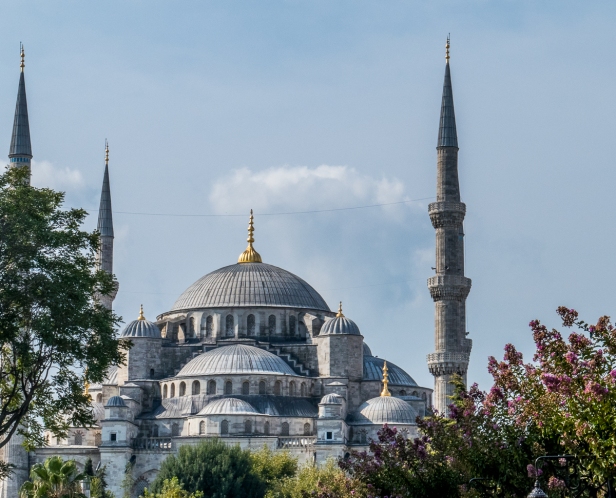
We enter a huge, silent, and serene space. It is overwhelming in its beauty, comparable to any of the grand temples and cathedrals of the world. There are only perhaps a dozen people inside when we first enter, and in such an enormous space it feels almost as if we have the place to ourselves. I stand awed, slowly taking in the spacious whole, and the gorgeous details. Light streams in through the many stained glass windows. It is glorious.

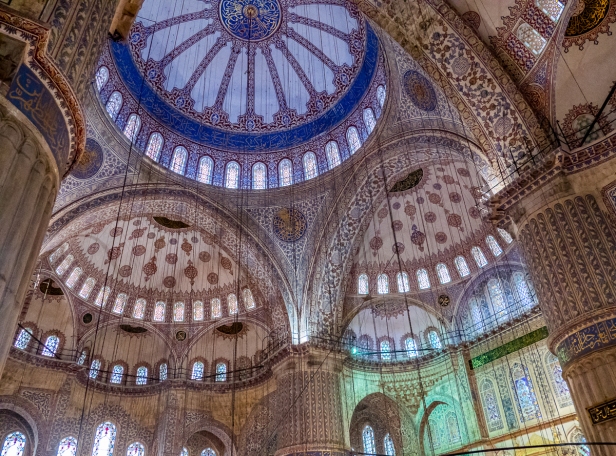
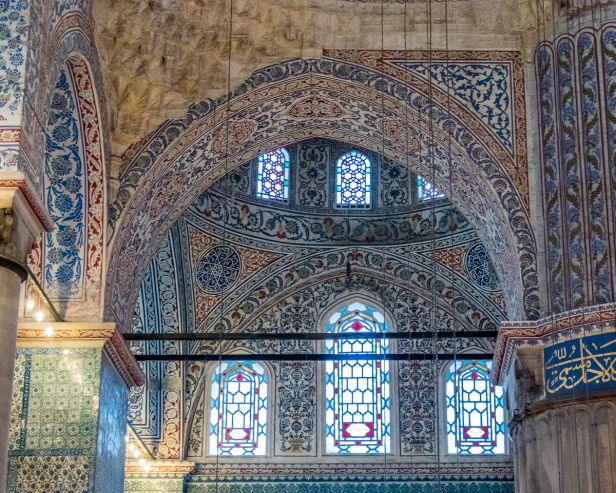
This photo of Don in front of one of the four main support columns gives an idea of their size.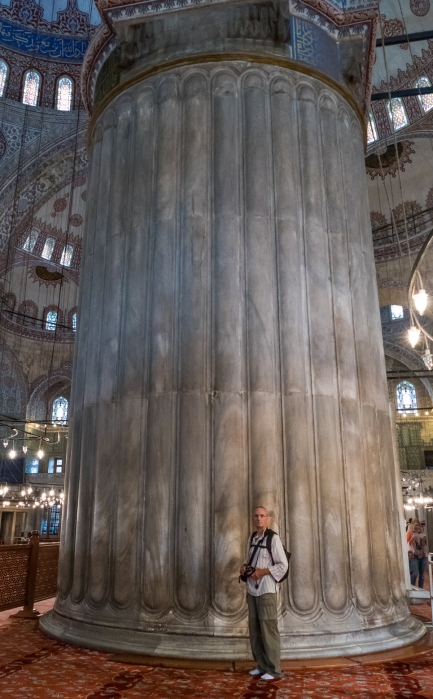
By the time we leave about forty minutes later the public area is crowded and noisy. Gone is that quiet contemplative energy and the space to see this exquisite place uninterrupted.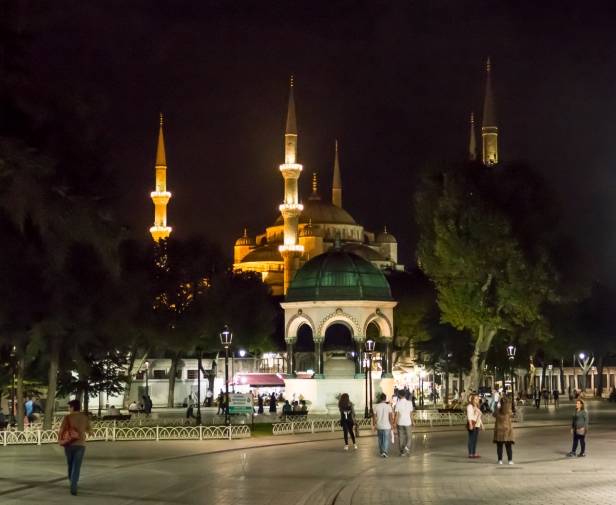
Next post: either more of the wonders of Istanbul, or I might jump around a bit and take you to the glory of ancient Rome at Ephesus, and some lazy days out on the Aegean and the Mediterranean swimming and snorkelling and eating fabulous barbeque. Or maybe something about settling into our latest home in San Miguel de Allende, Mexico.
All words and images by Alison Louise Armstrong unless otherwise noted
© Alison Louise Armstrong and Adventures in Wonderland – a pilgrimage of the heart, 2010-2015.

Always great to hear reports on your travels! What camera are you carrying with you? Thanks -Sid
LikeLiked by 1 person
Thanks so much Sid. I’m glad to hear you’re enjoying the blog. My camera is a Panasonic FZ1000 with a built-in 25-400mm zoom. It’s not so good in low light, but very good for most of what I want.
Alison
LikeLike
Brilliant photographs, Alison! I love traveling with you two via blogland and sharing these posts with my husband. I am very struck by the photo of the seagulls of the ocean. I could comment on the others as well, but the seagulls stand out to me: soaring! Looking forward to more!
LikeLiked by 1 person
Thanks so much Ka. I’m so glad to hear you love travelling along with us, and that your husband likes the posts too. Thank you re the seagulls – I loved watching them flying along with the boat. They’re so graceful, and wild and full of personality!
Lot’s more coming! 🙂
Alison
LikeLiked by 1 person
Oh my, this brings me back to our time in Turkey, and sounds like a similar route. I would have shared your anxieties about the bus! I love your photos, especially sunset and the fishermen, and the ladies in the colourful skirts and scarves…and the blue mosque, wow! I’m with you on the 8 days in Istanbul; a lifetime could be spent exploring this city! Too bad about recent events. Btw, I’d love to hear about San Miguel.
LikeLiked by 1 person
Thanks Caroline. Oh that shuttle ride! It was not comfortable at all but we got there in the end with no problems. I’m also pleased with the photos you mentioned. The one of the ladies was one of those wonderful moments of serendipity – right place, right time, right camera settings! I don’t know if you follow Jeff at planetbell.me. Full disclosure I stole the idea for the photo of the fisherman at sunset from him! Stealing an idea? It’s a compliment no?! 🙂
That first shot of the interior or the Blue Mosque – I’m glad I remembered to get down really low – I think that helped to get feeling for the whole huge interior space.
San Miguel will be coming soon! 🙂
Alison
LikeLike
Absolutely gorgeous Alison!
LikeLike
Thank you Cindy. It’s wonderful place!
Alison
LikeLike
Oh. my. gosh. This is absolutely, completely, totally 100% amazingly beautiful. This post is just incredible. I am now longing to go there just from looking at those pictures and reading what you have to say. This is sooo cool. Ah! Oh my gosh haha
LikeLiked by 1 person
Thank you so much Callie! Oh do go to Istanbul – it’s a fabulous place, rich and vibrant and full of life, and wonderful photo opportunities!
Alison
LikeLiked by 1 person
No, thank YOU! I really enjoyed this post! And I do hope to go one day.
LikeLiked by 1 person
Beautiful photographs Alison. Brought back lovely memories of our 3 weeks there last year. Looks like you had a grand time!! Great post.
LikeLiked by 1 person
Thanks Peta. Yes we had a wonderful time. What a fabulous city it is. You must have been able to see and experience a lot in three weeks!
Alison
LikeLike
Just loved it all so much. And as always your stunning photography. Feel as though I’m travelling with you.
LikeLiked by 1 person
Thank you Ros! It’s the best compliment to hear you feel as if you’re travelling with us!
Alison
LikeLike
One of the best reports on Istanbul I have read!! I love the sunset picture with the men fishing from the bridge. The blue mosque is incredible! Look forward to more surprises in the next post.
LikeLiked by 1 person
Wow, thank you so much Darlene. I stole the idea for the fishermen-sunset picture from Jeff Bell 🙂 – he’s a great photographer. Yes – the Blue Mosque is definitely incredible, one of the most beautiful buildings I’ve seen.
Alison
LikeLike
I have visited Turkey few times, but have never been to Istanbul. It is such a fascinating place and your photos are amazing. I love your writing and how you describe a place, but also you give a very personal touch with stories of how the journey was like to get there. I think my husband would particularly like the ” fishing street” 😀
LikeLiked by 1 person
Thanks so much Gilda. It is a fascinating place so I think you’d better go back to Turkey and visit Istanbul! 🙂
That shuttle ride was definitely an adventure! And fishing street was a rich cultural find. One of the things we love while travelling is just to go walking, and see what we can discover away from the regular tourist haunts.
Alison
LikeLike
Really enjoyed this post. You’ve captured the atmosphere so well and brilliant photographs.
LikeLiked by 1 person
Thanks so much Tim/Anne. I’m glad you enjoyed it. And I’m glad we got there before things started going a little sideways. With the bombings in Ankara a couple of months ago, and now this latest one it’s feels a bit dicey, though if we listened to all the places to not go to because they are dangerous we’d practically never go anywhere!
Alison
LikeLiked by 1 person
We were wondering how you felt in Turkey this summer. It is definitely somewhere we’d love to spend some time but every time we start to feel comfortable about it there is another incident. However as you say if we get too worried we’ll never go anywhere. Cheers, Tim & Anne
LikeLiked by 1 person
We felt safe the whole time we were there. We deliberately didn’t go anywhere near the eastern half of the country even though there’s lots to see there – that was getting a bit too close to Iran/Iraq/Syria/Kurdish Territory to be comfortable. I think it’s just a matter of a bit of careful assessment. Western Turkey seemed completely fine to us, and with the recent bombings there, and in Paris, I think there’s probably not anywhere that’s completely safe, but isn’t life like that anyway?!
Alison
LikeLike
This is a very beautiful post. You have some great photos of the people and mosques and really take us there with you.
It is funny how shuttle buses work in places. Last year in Indonesia I had the awful seat next to the driver with my head 12 inches from the glass. We would be driving down about 8000 feet of volcano on a treacherous road. As I looked for a seat belt the driver said, “No problem. No police on this road.” I wasn’t too worried about the cops giving me a ticket!
LikeLiked by 2 people
Thank you so much Jeff. I do try to create evocative posts. I must thank you once again for the fisherman-sunset photo idea. It seems to have been a hit!
Amazing the response about the lack of seat belts. Must have been a stimulating journey! 🙂
Alison
LikeLike
So lovely. Wherever you decide to go next in your blog, I’m right there with you!
LikeLiked by 1 person
Thanks Marsha, glad you enjoyed it. Istanbul is a wonderful place.
Alison
LikeLiked by 1 person
Always look at your ‘Wonderland’ blogs. Love both the photos and the writing. Thanks for taking me along with you. Keith.
LikeLiked by 1 person
Thanks you so much Keith. Comments like this make my day! And we’re happy to take you along with us. 🙂
Alison
LikeLike
Fabulous post and fabulous pictures. Thanks for such a wonderful portrait of Istanbul. I have been there many times, but not for many years. We were hoping to get posted there at one point but it never happened. I would love to go back again one of the days. Caroline
LikeLiked by 1 person
Thank you so much Caroline. You obviously know what a fabulous city it is. We loved it – so much to do and see.
Alison
LikeLike
After the years when we traveled regularly to Turkey, I discovered a trilogy by John Julius Norwich called Byzantium. He’s a historian and the book should be slow going and heavy, but he writes with such human interest that I found myself reading all three books and really learning a lot about that period in history. I highly recommend it if you like history and would like to know more about the city.
LikeLiked by 1 person
I love these kind of historical novels. Unfortunately photography, blogging and writing take up so much of my time these days I hardly have time to read. Still I think I’ll seek them out – even if I only read a few pages each night. Thanks for the recommendation.
Alison
LikeLike
Beautiful words and photos, as usual! Your shuttle story sounds even scarier than our bat-out-of-hell driver from Goreme to Kayseri in the early morning hours one day. I didn’t fear missing the flight as much as losing my life on the side of an empty road at 4 am! Your inside shots at the Blue Mosque are so good; I had trouble capturing the color and detail and overall grandeur in there. I’m right here waiting to read whatever you decide to post next!
LikeLiked by 1 person
Thanks Lexie, more to come! Your shuttle ride sounds terrifying. Life is so random. You never know what you’re going to get. I think my best interior shot to the Blue Mosque is the first one where I was practically lying on the floor to try to capture the grandness of the space.
Alison
LikeLiked by 1 person
Amazing photographs, especially the people the lovely portrait of the mother and son and the local women in their colourful dresses and I wonder how the man jumping into the water managed to keep his sandals from falling off…Where ever you take us next Alison I will look forward to following you.
LikeLiked by 1 person
Thanks pommepal. I was really pleased with that shot of the woman with her son – such a sweet moment. And we too noticed the man’s sandals! I think the photo of the women in their colourful dresses will become one of my favourite photos of the year.
Alison
LikeLiked by 1 person
Great post and beautiful photos! Istanbul is such a fascinating city, been there once. The Blue Mosque is absolutely stunning!
LikeLiked by 1 person
Thank you so much Piia. I agree about Istanbul – fabulous place. And the Blue Mosque was a highlight. I’m so glad we made the effort to get there very early and see it before the crowds poured in.
Alison
LikeLike
After I finish sighing! Yes, it looks a fascinating place 🙂 Lots more excitement to come!
I tried to respond to your comment on my hellebores, Alison, but the comment has mysteriously disappeared. Not in Spam, either! Mysteries of WP- but thank you, anyway 🙂
LikeLiked by 1 person
Thanks Jo. It is a fascinating place!
Weird about the hellebores comment. WP is sometimes like that eh.
Alison
LikeLiked by 1 person
Cold and snowing here, your photos take me to a much warmer place in time. What was the temperature/humidity like during your stay in Istanbul?
LikeLiked by 1 person
It was mostly quite warm. There was one massive downpour while we were there, but apart from that it was lovely.
Alison
LikeLike
How wonderful to sit recovering in my warm room in Tennessee and get to see the exotic and exciting sights of Istanbul through you. Your wonderful photography gave me a better feel for the size, beauty and serenity of the Blue Mosque than any travelogues or paintings I’ve seen. Thank you so much for getting up so early and so thoughtfully and sensitively helping us experience this with you. And your mix of local every day life and people with the amazing natural beauty gives us a depth experience, not just a collection of “sights.” And it was all balanced with the hair raising reality of transportation in another world from ours. I was with you all the way thanks to your descriptions…..just glad neither you nor I needed a pit stop during those adventures.:)
Blessings…..
LikeLiked by 1 person
Thank you so much Eileen. I’m glad you enjoyed the post so much and that I helped transport you a little to the wonders of Istanbul. It was a wonderful time for us, a rich experience. And yes, I’m very thankful I didn’t need a pit stop on that hair raising journey!
Alison
LikeLike
Hi Alison and Don, Winter months and I am blogging again and what a delight it has been to catch up and read of your travels. This post is awesome, I sometime forget what exotic places exist beyond our little farm! My daughter invited me to spend ten days with her family in Mauritious for new year so I have been on the move too. It was fabulous but I am happy to be home even though it won’t stop raining!
Happy travels, Roz Hill 💚💛💜❤️💙
LikeLiked by 1 person
Hi Roz! Thanks so much – glad you’re enjoying the stories of our journeys. I guess we have been to some pretty exotic places recently (Jordan and Egypt came after Turkey), But Mauritious! I’d love to go there one day. Ah yes, the lovely British winter rain – much like the lovely Vancouver winter rain – endless, but it does keep everything green. We’re in the hills in Mexico – it’s not that warm, but at least there’s not much rain, most days are sunny.
Alison
LikeLiked by 1 person
Good to catch up! Safe travels💚💛💜❤️💙
LikeLiked by 1 person
Sigh, what a dreamy post this is, Alison. Your photography just keeps getting better and better – you capture Istanbul so beautifully and I could easily picture these shots in a glossy travel magazine! I love how you also wove in the geography and history surrounding the Bosphorus – without it, the city might never have come to exist.
LikeLiked by 1 person
Thanks James. I’ve been having a photography lesson or two from my sometime-pro photographer sisters. It helps. I’d love to see my photos in a glossy travel mag!
Istanbul is an amazing city, and of course the Bosphorus was (and is) so important strategically that it was inevitable I guess that people would settle there, and fight over it.
Alison
LikeLiked by 1 person
enjoyed the past
& present
beautiful expression
of Turkey 🙂
LikeLiked by 1 person
Thank you
It’s a pleasure
to share the wonders
of this country.
Much more to come.
Alison
LikeLike
I stayed in Istanbul for about a week and wished I had another week there. It was such a magical city, rich with culture and history. Probably even if I did have that extra week I would have ended up asking for another week. Beautiful post and photos, Alison, from one of the most photogenic cities on the planet.
LikeLiked by 1 person
Thank you so much Bama. I agree, it is a very photogenic, and fascinating, city. I’m glad we had nine days there, one at the beginning and another eight when we returned. We filled them all up no problem – so much to see and do.
Alison
LikeLike
Beautiful captures…id love to go back and photograph again….
LikeLike
Thanks Hedy. What a place! So much to catch the eye.
Alison
LikeLike
Beautiful, beautiful, BEAUTIFUL photographs which made me sigh with longing…the UK is very grey right now…thanks for brightening my day. x
LikeLiked by 1 person
Thank you so much! I’m glad it brightened things up a bit for you. Yeah, the UK in winter – very grey, but at least it keeps things green!
Alison
LikeLiked by 1 person
Istanbul is the one place I’ve just really really wanted to visit. It is so magical and mystical. The mosques, the sea, the colors, the markets, the people. I really want to go. This is a gorgeous post with so many fantastic photos Alison. Can’t wait for the next installment. 🙂
LikeLiked by 1 person
Thanks so much Nicole. Istanbul really is magical and mystical, for all the things you mentioned. I’ll be doing posts on the Grand Bazaar, and the spice market soon – both amazing.
Alison
LikeLiked by 1 person
Looking forward to the posts Alison!
LikeLiked by 1 person
I really like that very first photo of the Blue Mosque at sundown. And then the interior shots came out VERY well, eh? I’m always amazed at your bird shots…the two gulls here…because they always seem to pose properly for you, and you get them in focus. Your telephoto seems to be working really well, also, because those shots print nicely also. And we really do seems to be on the same page with things, because we’ve both posted about “transport fear” and I just recently read an article about the global warming at the end of the last ice age being the cause of what the call “the great flood.” Interesting, eh?
LikeLiked by 1 person
Thanks BF. I was really pleased with the interior shots of the Blue Mosque, particularly the first one. I think most of my bird shots are just lucky. I set a high shutter speed and then point the camera at the sky and hope I get something in the frame. Mostly I don’t, but sometimes I’m quick enough. The telephoto is great in full daylight, not so good in low light.
Yeah, transport fear – it’s that feeling that your whole life rests in someone else’s hands. I got that *a lot* in India. And us both reading about the Great Flood at the same time. Synchronicity! I think a butterfly flapped its wings somewhere. I had no idea until I started reading up about the Bosphorus that the great melt could have been the cause.
Alison
LikeLike
Simply amazing journey into a region I’m looking forward to seeing. l loved your descriptions and gorgeous photos (those faces and colors!) as well as how you mixed ancient history and geography in a way that made your post relevant to current events. Great story and a “You are There” vibe! Anita
LikeLiked by 1 person
Thanks so much Anita. I am always really pleased to hear that a post gives the feeling of being there. I certainly strive for that. I think some historical context is important, but I’m no historian that’s for sure, and I guess too much of it can be a bit of a yawn. I love photographing the people of the places we go to. In one future post on Turkey I plan on writing about how the women dress. The range was vast, but those four young women on Galata Bridge in their bright colours was definitely a lucky capture.
Alison
LikeLike
I don’t know how you have time to do all this research! Your writing here was great– you just sink right into it and get carried along. And I agree the photos of the Blue Mosque really put the size into perspective. Those columns are massive…. Reminds me of Christopher Alexander’s writings on scale, and how sometimes columns should be bigger than is necessarily required structurally, so that they have the proper volume in the space. Although maybe they’re sized just right. Hard to say!
I loved the bags of colored powders. That looked delightfully dangerous.
And do you know what that silver pipeline was above the bridge? Part of the bridge or actually conveying something over the river?
Love
Michael
LikeLiked by 1 person
Thank you Michael for your lovely compliments. It’s so good to hear you got carried along with the journey. I like that. I don’t know if the columns in the Blue Mosque were bigger than needed or not, but they sure are huge. I suspect the pipeline above the bridge must carry something but I don’t know what. I loved all those powders – what fun you could have with them! As for research – it comes in fits and starts. It’s not like I’m working, except on the blog. And at the moment we’re not travelling so I have plenty of time. I do try to find the nuggets.
Alison
LikeLiked by 1 person
Incredible pictures!! Thank you for sharing 🙂
LikeLiked by 1 person
Thank you so much. I’m glad you enjoyed them. And you’re most welcome! 🙂
LikeLiked by 1 person
I’m waiting to read about your next travel 🙂
LikeLiked by 1 person
More about our travels n Turkey coming today or tomorrow 🙂
LikeLiked by 1 person
Looking forward to it 😀
LikeLiked by 1 person
Loved Istanbul. I sometimes wonder what you do carry about with you on your worldly travels. You obviously have some camera gear and a computer and presumably some clothes – maybe some medications, glasses. What about books? It might make an interesting topic for a post sometime – “What a nomad really needs”.
LikeLiked by 1 person
We loved Istanbul too. I have at least two more posts to write about it – there was so much to see and do there.
I have written a post about what we carry. It’s a bit buried, it was a long time ago, and it need updating, but most of it is still accurate. https://alisonanddon.com/2012/10/10/canberra-australia-part-1/
As for camera equipment it’s one of my biggest compromises – apart from the cost factor I’ve basically traded sensor size for a built-in 25-400 zoom lens and built-in flash, so I don’t have a whole bunch of pieces to carry around. I sometimes wonder if it’s worth it. I looked at mirrorless but couldn’t find the lens I wanted in my price-range. I’ve heard there are new cameras coming on the market that will have mega mega pixels so you can zoom digitally without losing quality. I’m hoping to upgrade maybe in a year or so. But I still want it to be just one piece, or something small enough that all the pieces can fit in my camera bag.
Alison
LikeLike
Wow, way to go…we just returned back to Tamil Nadu in South India after a week in Bali, Indonesia. Alison & Don, Thanks for the pictures and writings.
LikeLiked by 1 person
Thanks. Istanbul is a fabulous city.
We lived in Tiruvannamalai for 3 months back in 2012, and then in Bali for a month right after that.
Alison
LikeLike
Oh, that’s nice Alison…am at home now and thinking a lot about going some to Tiruvannamalai or Pondicherry to visit and possible meditate…yesterday, locally, spent a lot of time at the Universal Temple in Mylapore…
LikeLiked by 1 person